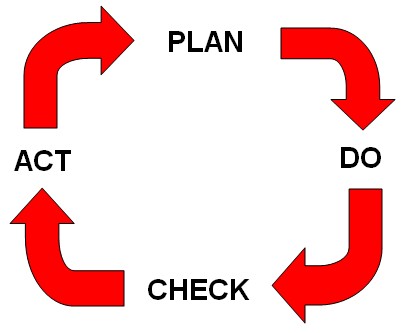The Deming Cycle
or PDSA and PDCA
One of the most common tools for improvement is the Deming (or Shewhart) Cycle.
This method is also known as Plan-Do-Check-Act (PDCA) or Plan-Do-Study-Act (PDSA) and it is well suited for many improvement projects. Originally known as PDCA, it was revised to PDSA in the early 1990’s to reflect misunderstandings of the intent of learning process.
|
|
Many quality practitioners believed that the check stage of the process meant to simply measure the improvement and move forward to the Act stage. Deming was stressing the importance of studying the data collected prior to acting upon it by changing the name of the stage to study. Use of the Deming Cycle is so widespread that ISO 9001 includes the methodology as a means of process improvement.

Plan
The above picture shows how the Deming Cycle operates. The Plan stage is where it all begins. Prior to implementing a change you must understand both the nature of your current problem and how your process failed to meet a customer requirement. You and/or your problem solving team determine:
- Which process needs improved
- How much improvement is required
- The change to be implemented
- When the change is to be implemented
- How you plan to measure the effect of the change
- What will be affected by this change (documents, procedures, etc).
Once you have this plan, it’s time to move to the DO stage.
Do
The Do stage is the implementation of the change. Identify the people affected by the change and inform them that you're adapting their process due to customer complaints, multiple failures, continual improvement opportunity, whatever the reason, it is important to let them know about the change. You'll need their buy-in to help ensure the effectiveness of the change.
Then implement the change, including the measurements you'll need in the Study stage. Monitor the change after implementation to make sure no backsliding occurs. You wouldn't want people to return to the old methods of operation- those methods were causing your company pain to begin with!
Study
Just as it implies, the Study stage is where you’ll perform analysis of the data you collected during the Do stage. Considerations include:
- Did the process improve?
- By how much?
- Did we meet the objective for the improvement?
- Was the process more difficult to use with the new methods?
Act
The answers from the Study stage define your tasks for the Act stage. For example, if the process didn't improve, there's no point in asking additional questions during the Study stage. But action can be taken- action must be taken! The problem hasn't been solved. The action you'd take is to eliminate the change you implemented in the Do stage and return to the Plan stage to consider new options to implement.
If the process did improve, you'd want to know if there was enough improvement. More simply, if the improvement was to speed up the process, is the process now fast enough to meet requirements? If not, consider additional methods to tweak the process so that you do meet improvement objectives. Again, you're back at the Plan stage of the Deming Cycle.
Suppose you met the improvement objectives. Interview the process owner and some process participants to determine their thoughts regarding the change you implemented. They are your immediate customer. You want their feedback. If you didn't make the process harder (read more costly or time consuming) your action in this case would be to standardize your improvement by changing any required documentation and conduct training regarding the change. Keep in mind that sometimes you will make the process more time consuming. But if the savings from the change more than offset the additional cost, you're likely to have implemented an appropriate change.
Revisiting the Improvement
That's right… you're not done yet. You want to Sustain the Gain. Know that the change is still in place, and still effective. A review of the process and measure should give you this information. Watch the process to view for yourself that the process operators are performing the process using the improvements you've implemented. Analyze the metrics to ensure effectiveness of your Deming Cycle improvements.
Download our E-Book- Using the Deming Cycle
Visit the Carpenter Group Store




